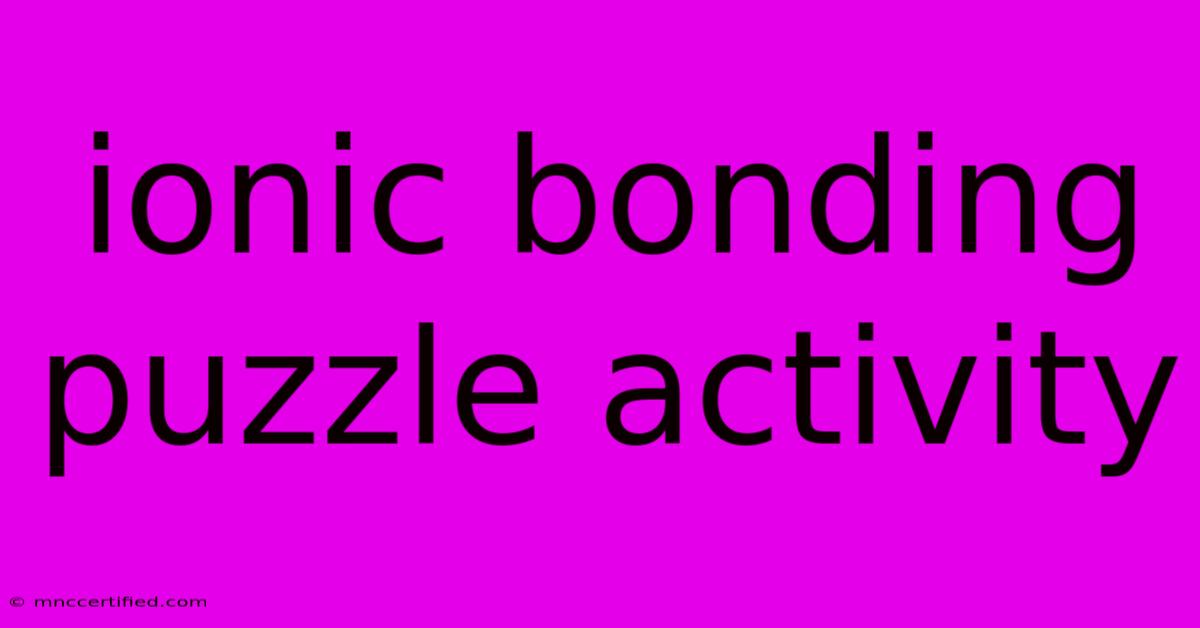Ionic Bonding Puzzle Activity

Table of Contents
Ionic Bonding Puzzle Activity: A Fun and Engaging Way to Learn Chemistry
Ionic bonding can be a tricky concept for students to grasp. Abstract ideas like electron transfer and electrostatic attraction require a more hands-on approach than simply reading from a textbook. That's where a fun and engaging ionic bonding puzzle activity comes in! This article will guide you through creating and using such an activity to enhance understanding and retention of this crucial chemistry topic.
Understanding Ionic Bonding: A Quick Recap
Before diving into the puzzle activity, let's briefly review the fundamental principles of ionic bonding. Ionic bonds form when electrons are transferred from one atom to another, resulting in the formation of ions. Atoms that lose electrons become positively charged cations, while atoms that gain electrons become negatively charged anions. The electrostatic attraction between these oppositely charged ions is what constitutes the ionic bond. This process often involves metals (which tend to lose electrons) and nonmetals (which tend to gain electrons).
Designing Your Ionic Bonding Puzzle Activity
The key to a successful puzzle activity is its design. Here's a step-by-step guide to creating an engaging and effective ionic bonding puzzle:
1. Choosing Your Elements:
Select a range of common elements that readily form ionic compounds. Consider including elements from Groups 1, 2, 16, and 17 of the periodic table. For beginners, sticking to simpler ions with predictable charges is advisable (e.g., Na+, Cl-, Mg2+, O2-). More advanced versions could incorporate transition metals with variable charges, adding an extra layer of complexity.
2. Creating the Puzzle Pieces:
Each puzzle piece will represent an element or ion. You can create these using several methods:
- Cardboard cutouts: Draw or print element symbols (e.g., Na, Cl) and their corresponding charges (+1, -1) onto individual pieces of cardboard. You can even add electron shell diagrams for a more visual representation.
- Printable puzzle: Design a printable puzzle where students cut out the pieces. This option allows for customization and easy reproduction. Many free online tools can be used to create custom puzzles.
- Digital puzzle: Utilize online puzzle makers or educational apps to create an interactive digital puzzle. This is especially beneficial for technology-integrated classrooms.
Regardless of your method, ensure the puzzle pieces are clearly labeled with the element symbol and charge. Using different colors for cations and anions can also improve visual clarity.
3. Designing the Puzzle Challenge:
The goal of the puzzle is for students to correctly combine cations and anions to form neutral ionic compounds. This can be achieved in several ways:
- Matching pairs: Create pairs of cations and anions that form stable compounds (e.g., Na+ and Cl- forming NaCl).
- Formula building: Provide students with a list of ionic compounds (e.g., MgCl2, K2O) and have them assemble the corresponding cations and anions.
- Crystalline structure simulation: For advanced students, create a puzzle that represents a simplified crystal lattice structure, requiring them to arrange ions based on their charges and sizes to build a stable structure.
4. Adding an Extra Layer of Challenge:
To increase the difficulty and engagement, consider incorporating the following:
- Polyatomic ions: Introduce polyatomic ions (like sulfate or phosphate) to challenge students' understanding of more complex ionic compounds.
- Balancing charges: Require students to determine the correct ratio of cations and anions needed to achieve charge neutrality.
- Real-world applications: Include examples of ionic compounds and their real-world applications (e.g., NaCl in table salt, CaCO3 in limestone) to make the learning more relevant.
Implementing the Ionic Bonding Puzzle Activity in Your Classroom
Once your puzzle is ready, follow these steps to implement the activity effectively:
- Introduce the concept: Briefly review ionic bonding principles before starting the activity.
- Distribute the puzzle pieces: Give each student or group their own set of puzzle pieces.
- Provide instructions: Clearly explain the goal of the puzzle and any specific rules.
- Facilitate the activity: Monitor student progress, answer questions, and provide hints as needed.
- Debrief and discuss: After completing the puzzle, have a class discussion to review correct answers, address misconceptions, and reinforce learning.
Off-Page SEO Strategies for Increased Visibility:
To improve the online visibility of this article and related content, consider these off-page SEO strategies:
- Social media sharing: Share the article on relevant social media platforms (e.g., educational groups, chemistry forums).
- Guest blogging: Write guest posts on educational websites and blogs relevant to chemistry education.
- Forum participation: Participate in online chemistry forums and contribute to discussions, linking back to the article when appropriate.
- Link building: Seek opportunities to have other educational websites link to this article.
By implementing this engaging ionic bonding puzzle activity and employing effective SEO strategies, you can significantly improve your students' understanding of ionic bonding and enhance the online visibility of your educational resources. Remember to adapt the puzzle complexity to suit the age and understanding of your students. Make learning fun!

Thank you for visiting our website wich cover about Ionic Bonding Puzzle Activity. We hope the information provided has been useful to you. Feel free to contact us if you have any questions or need further assistance. See you next time and dont miss to bookmark.
Featured Posts
-
Real Madrid Vs Liverpool Confirmed Starting Lineups
Nov 28, 2024
-
H E B Open On Thanksgiving Find Nearby Stores
Nov 28, 2024
-
Real Estate Investment Metrics
Nov 28, 2024
-
Lana Del Rey 2025 Tour Presale Codes And Info
Nov 28, 2024
-
Breaking Bread Building Bonds
Nov 28, 2024